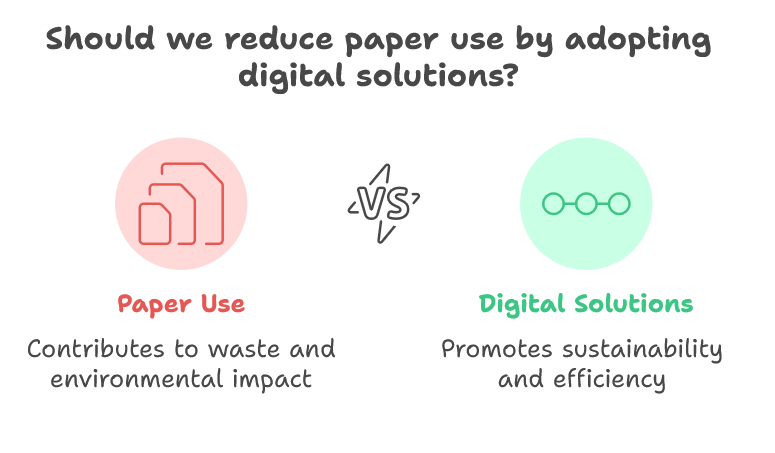
Cutting the Carbon: Simple Steps to Reduce Office Emissions
Table of Contents
Offices—whether large corporate campuses or modest home-work environments—collectively contribute significantly to carbon emissions. From daily commutes to energy-hungry lighting and endless paper printing, the office environment can become a hotspot for inefficient resource use. The good news? Simple, incremental changes can yield significant carbon cuts, often paired with cost savings and a morale boost for staff who appreciate greener policies.
This article explores practical strategies to reduce an office’s carbon footprint. We’ll cover remote work, digital transformations, waste management (including a brief reference to solutions like recycling balers), and the value of AI/digital training in driving continuous improvement.
“Many of these carbon-reducing measures aren’t rocket science—just incremental behaviour and tech usage shifts. But collectively, they can significantly cut emissions and costs while motivating employees,” says Ciaran Connolly, Director of ProfileTree.
Reimagining Office Work: Remote and Virtual Strategies
The future of office work is shifting, with remote and virtual strategies offering greater flexibility, productivity, and collaboration. This transformation helps businesses adapt to new technologies and meet evolving workforce expectations.
Minimising Daily Commutes
Transport often accounts for a significant proportion of an office’s emissions. Encouraging staff to work remotely, even one or two days a week, significantly lowers commuting miles. Tools like Zoom or Microsoft Teams have become ubiquitous, making day-to-day collaboration seamless.
- Hybrid Models: Offer staff the flexibility to choose remote vs. in-office schedules. This lowers carbon emissions and office space requirements (potentially saving on rent, lighting, and heating).
- Incentives: Provide perks for those who cycle, carpool, or subsidise public transport passes. A greener commute fosters team spirit and public goodwill.
Virtual Meetings Over Business Travel
Online calls or video conferences often replace intra-company flights or lengthy car journeys for client catch-ups. While face-to-face interaction remains valuable in some instances, defaulting to digital can slash travel emissions and save considerable time. A 15-minute Zoom might suffice where previously a half-day trip was deemed necessary.
Stat: According to specific corporate travel surveys, implementing a digital-first meeting approach can reduce annual travel-related emissions by 30–40% for mid-sized organisations.
Cutting Paper Use: Embrace Digital Solutions

Reducing paper use is essential for improving efficiency and sustainability. Embracing digital solutions not only helps streamline processes but also supports environmental goals, leading to a more eco-friendly and productive workplace.
Paperless Processes
Despite the prevalence of digital tools, offices still waste reams of paper on printing emails, forms, or handouts. Introducing a paperless policy can drastically reduce both waste and costs:
- E-Signatures: Platforms like DocuSign or Adobe Sign allow digital legal documents to be validated, removing the need for physical printouts.
- Cloud File Sharing: Tools like Google Drive or OneDrive keep documents accessible anywhere, eliminating the “printed backups” mindset.
- Online Collaboration: Project management software (Trello, Asana) or digital whiteboards (Miro) replicate tasks once scribbled on sticky notes and pinned to walls.
Automated Approvals and AI Document Management
Approvals—like expense forms or purchase orders—are often manually circulated. Digitising and automating approvals via AI or workflow apps speeds up the process, with an electronic record for accountability. AI-based text recognition can also help convert old paper records into searchable digital archives, cutting storage needs and making data more accessible.
Note on Recycling Equipment: Offices dealing with a fair amount of paper can look into advanced recycling solutions or balers to compress recyclable waste. While not the final brand mention, referencing such equipment emphasises that going entirely paperless might be gradual, and in the interim, optimising paper recycling is key.
Sustainable Energy Practices and Equipment Choices
Adopting sustainable energy practices and making eco-conscious equipment choices are key to reducing environmental impact. By prioritising energy-efficient solutions, businesses can lower costs, enhance sustainability, and contribute to a greener future.
Energy-Efficient Hardware
Replacing outdated desktop PCs, printers, or lighting can yield immediate energy cuts:
- LED Lighting: Consumes up to 75% less energy than traditional bulbs and lasts significantly longer.
- Laptops vs. Desktops: Laptops use less power, and modern cloud computing setups mean you don’t need heavy on-premise servers.
- Smart Power Management: Timers or sensors to ensure machines and lights switch off automatically during non-usage times.
Renewable Energy Options
Even if you’re a tenant in a shared office, you can lobby your building management to transition to green electricity suppliers—providers that source power from wind, solar, or hydro. Installing rooftop solar panels might be viable for smaller offices or standalone buildings, offering long-term payback and lower reliance on the grid.
Heating/Cooling Optimisation
AI-enabled thermostats and HVAC systems can learn occupancy patterns, adjusting temperatures accordingly. This approach, widely used by modern offices, can cut HVAC energy usage by up to 20%. Simple measures like sealing windows, adding insulation, or using natural ventilation in mild climates also reduce reliance on energy-intensive heating or air conditioning.
Managing Office Waste Responsibly
Managing office waste responsibly is crucial for promoting sustainability and reducing environmental impact. Implementing effective waste management strategies helps minimise landfill contributions, conserve resources, and fosters a more eco-friendly workplace.
Building a Culture of Recycling
Encourage staff to recycle everything from paper and cardboard to plastics. Provide clearly labelled bins—one for mixed recyclables, one for general waste, and one for compostables if applicable. Education is key: a short induction or monthly reminder helps people sort items correctly.
Minimising Single-Use Plastics
Take stock of disposable cups, water bottles, or takeaway meal packaging. Offering reusable cups or installing a filtered water dispenser encouraging staff to use personal bottles can reduce plastic waste drastically. Some offices provide labelled metal cutlery sets in the kitchen, eliminating plastic utensils.
Subtle Mention of Recycling Equipment: If large volumes of cardboard or paper must be discarded, a baler or compactor (from any reputable recycling equipment provider) compresses it into manageable bales, cutting disposal costs and ensuring materials are easily transported for recycling. This is especially helpful in offices receiving many shipments or producing a steady stream of packaging waste.
Engaging Digital and AI Training for Continuous Improvements

Engaging digital and AI training is essential for fostering continuous improvement in the workplace. By equipping employees with the latest skills and knowledge, businesses can drive innovation, enhance productivity, and stay ahead in a rapidly evolving digital landscape.
Why Training Matters
Adopting remote working tools, digital approvals, or AI-based processes can feel daunting if staff lack exposure. Regular training ensures employees understand the tech and feel comfortable using it daily. A well-trained team is likelier to propose new efficiency ideas or identify further carbon-reducing opportunities.
AI’s Role in Monitoring
Simple AI dashboards can gather data from smart plugs, printers, or HVAC systems to track real-time usage. They highlight anomalies (“Why did we use 40% more energy last weekend?”), prompt energy-saving reminders, or even auto-adjust settings. Staff training on interpreting these dashboards fosters a sense of ownership—colleagues see how their behaviour influences the office’s carbon footprint.
Collaboration Tools
Digital transformation is a key enabler of carbon reduction. By teaching staff to collaborate in the cloud, they produce fewer printouts, rely less on physical meetings, and maintain secure archives. This synergy of digital literacy and environmental awareness sets a foundation for more profound sustainability efforts.
“Sustainability thrives on informed employees. When people learn how to leverage AI or digital tools effectively, they become active participants in cutting our carbon impact,” explains Ciaran Connolly.
Practical Checklist for Reducing Office Emissions
- Commute & Travel
- Encourage remote/hybrid work; provide secure collaboration tools.
- Incentivise public transport, cycling, or carpooling.
- Default to video calls for non-critical travel.
- Paper & Printing
- Introduce e-signature platforms.
- Use cloud storage for file sharing and collaboration.
- Print only when necessary; use double-sided mode.
- Energy Efficiency
- Switch to LED or sensor-based lighting.
- Optimise HVAC with AI-based or programmable thermostats.
- Migrate older servers to cloud solutions or modern low-power hardware.
- Waste & Recycling
- Provide labelled recycling bins and compost options.
- Reduce single-use plastics in the kitchen area.
- Use compactors or balers for high-volume recyclable waste.
- AI & Digital Integration
- Use AI dashboards to monitor energy usage or resource consumption.
- Automate routine tasks (approvals, data entry) to reduce paper, time, and mistakes.
- Offer staff training on collaboration software and sustainability best practices.
By systematically ticking off items on this list, offices large and small often see noticeable carbon reductions within months—plus improved morale among employees who appreciate a greener workspace.
Future Outlook: Going Beyond the Basics
The future of business is about more than just meeting basic requirements. Going beyond the basics involves embracing innovation, advanced strategies, and continuous adaptation to stay competitive and drive long-term success in an ever-evolving landscape.
Deep Green Office Innovations
As technology evolves, offices may adopt IoT sensors everywhere: real-time occupant tracking, dynamic LED arrays adjusting brightness based on daylight, or “smart windows” changing tint to regulate heat. Some companies experiment with battery storage or on-site renewable microgrids, further decoupling from fossil-fuel-based power.
Leveraging AI for Holistic Resource Management
Beyond day-to-day operations, advanced AI might orchestrate the entire facility’s resource consumption—balancing water usage, waste disposal schedules, and even occupant comfort in real-time. The same system might integrate with supply chain data, ensuring minimal delivery packaging or suggesting alternatives to high-carbon materials.
Circular Economy Transition
Forward-thinking offices gradually adopt circular economy principles: renting furniture from providers who refurbish and reuse it, composting organic waste from communal kitchens, or collecting used electronic devices for certified recycling. AI can track the lifecycle of assets, prompting maintenance or replacement before breakdown occurs.
Sustainability as a Core Office Ethos
Cutting carbon in the office is more than just a checklist—it’s a cultural shift. By embracing remote and digital workflows, reducing paper use, optimising energy consumption, and instilling recycling habits, companies move closer to carbon neutrality while fostering a more productive, engaged workforce. AI and digital training amplify these efforts, ensuring continuous monitoring, data-driven decisions, and seamless collaboration.
As employees see tangible changes—like reduced commutes, less clutter, or real-time energy dashboards—they often feel pride in working for an employer that cares about the environment. This pride translates into positive brand perception externally. From a purely business standpoint, each step towards cutting emissions often correlates with operational efficiencies and cost savings.
Looking for more ways to go green beyond the office? Check out our next article, “Sustainable Hosting & Tech Infrastructure: The Next Frontier for Green Business,” where we dive into how choosing eco-friendly hosting providers and optimising IT practices can further shrink your organisation’s carbon footprint.




